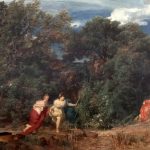Alongside Hans Holbein the Younger, Arnold Böcklin (1827–1901) is one of the ‘patron saints’ of the Kunstmuseum Basel. The museum holds over 90 paintings and sculptures by the artist, making it the most important collection of his works in the world. In the late 19th century, Böcklin, who was born in Basel, achieved enormous fame in the German-speaking lands and is now seen as one of the key exponents of Symbolism.
During the Corona-Crisis, Swiss artist Arnold Böcklin’s symbolist painting “The Plague” (1898) became prominently displayed in the media as illustration of the pandemic. This work is currently on display at Kunstmuseum Basel, in an exhibition that’s titled “Encountering Böcklin” (Böcklin Begegnet).
The show is an excellent introduction to Arnold Böcklin’s oeuvre and his time. Configured in twelve groupings, works by Arnold Böcklin (1827-1901) are juxtaposed with those of his predecessors, contemporaries and unexpectedly like-minded artists, allowing key biographical, stylistic and thematic aspects of his oeuvre to emerge. This is the first of four videos in which curator Eva Reifert introduces us to these groupings of works.
In this video, Eva Reifert talks about three groupings:
AQUATIC GAMES: Arnold Böcklin, (Play of the Nereides, 1886), and Félix Vallotton, (Three Women and One Little Girl, 1907).
CASTING A LONG SHADOW: Arnold Böcklin, (The Isle of the Living, 1888); and Walter Kurt Wiemken, (Life, 1935)
LANDSCAPES OF THE SPIRITUAL: Arnold Böcklin, (The Sacred Grove, 1882); and Cy Twombly, (Study for Presence of a Myth, 1959).
Encountering Böcklin (Böcklin Begegnet) at Kunstmuseum Basel. Basel (Switzerland), June 15, 2020.
–– Right-click (Mac: ctrl-click) this link to download Quicktime video file.








